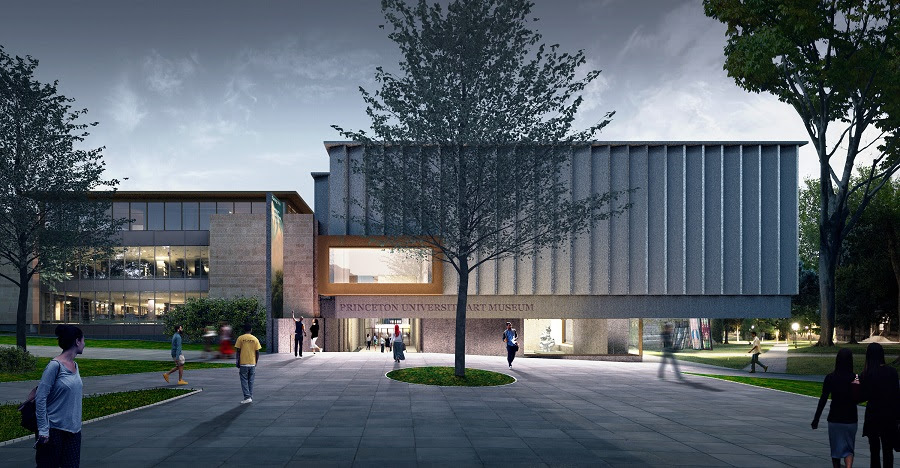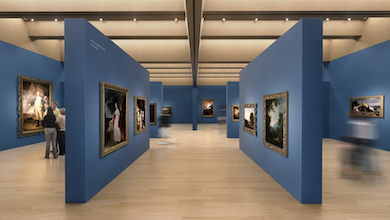
PRINCETON, N.J. – Construction has begun on the new Princeton University Art Museum, an entirely new building on the site of the former museum, at the heart of the Princeton campus. Roughly doubling the square footage of the existing facility, the 144,000-square-foot facility significantly increases spaces for display, learning and visitor amenities.
The museum, which will occupy three stories, will insert itself dynamically into campus life with key pedestrian pathways flowing into and through the building via two art walks — thoroughfares that function as the new building’s circulatory spine. A grid of nine pavilions breaks down the scale of the complex into more intimate modules and allows for deeply varied gallery experiences.

The building’s exterior will be characterized by rough and polished stone surfaces responding to the campus surroundings, as well as signature bronze details throughout, alternating solid elements with more transparent features that speak both to the present moment and to the historical Princeton context. The architect Sir David Adjaye, whose firm, Adjaye Associates, is best known for its design of the Smithsonian’s National Museum of African American History and Culture, was selected as the project architect in 2018. Cooper Robertson is the executive architect.
With expansive and growing collections of more than 112,000 globe-spanning works of art from antiquity to today, the Princeton University Art Museum is a major center for the study of the humanities and the visual arts in the United States. The new building underscores Princeton’s enduring commitment to humanistic education and the museum’s commitment both to object-based inquiry and to marrying scholarly excellence with accessibility.

The new facility will also house Princeton’s Department of Art and Archaeology and Marquand Library; together, the three units will continue to function as a leading site for research and teaching. The design overcomes multiple historical barriers to participation, making the visual arts an essential part of the University experience for all Princeton students and an accessible home of democratic engagement for community members and visitors.
Contracts were awarded in June 2021, and during the summer demolition began on the former museum complex, most of which dated to periods of construction in the 1920s, 1960s and 1980s.
“David Adjaye’s design for Princeton reflects our deep commitment to the values of openness, transparency and interconnectedness for our campus constituents, local communities and global audiences,” said James Steward, the Museum’s Nancy A. Nasher–David J. Haemisegger, Class of 1976, director. “It’s a remarkable opportunity both to build on the past and to shape a new museum at this particular historical moment, and in doing so to make clear the important role museums can continue to play in an ever more complex world.”

Princeton’s art collections date nearly to the University’s founding in 1746. The first work of art was acquired in 1755, making Princeton one of the oldest collecting institutions in North America. The museum was established as a museum of the Enlightenment, bringing together the fine arts, antiquities and natural history, and its collections were from the start seen as a way of bringing the world to the students in a crossroads village in Colonial New Jersey. A professionalized museum, along with an academic department for the study of art history — then a discipline newly imported from Germany — was established in 1882, provoking the construction of a purpose-built museum on the current site, which opened in 1890.

With demolition expected to be complete this month, concrete foundations to be poured starting this month and construction continuing into early 2024, the museum has undertaken a number of strategies to maintain its scholarly and public impact during the years of disruption. It is operating two gallery spaces in downtown Princeton within walking distance of the campus: Art@Bainbridge, a project space privileging installation work by emerging and early-career artists in an historic Revolutionary-era building, and Art on Hulfish, a larger gallery space of a more industrial character. Two outdoor exhibitions are also planned, beginning with the video work of the artist Doug Aitken. In addition, the museum will be touring four exhibitions to museums across the United States and Mexico while construction is carried out.
Please visit the museum’s website for digital access to the collections, a diverse portfolio of virtual programs and updates on opportunities to visit in person. See more information at the website artmuseum.princeton.edu.


